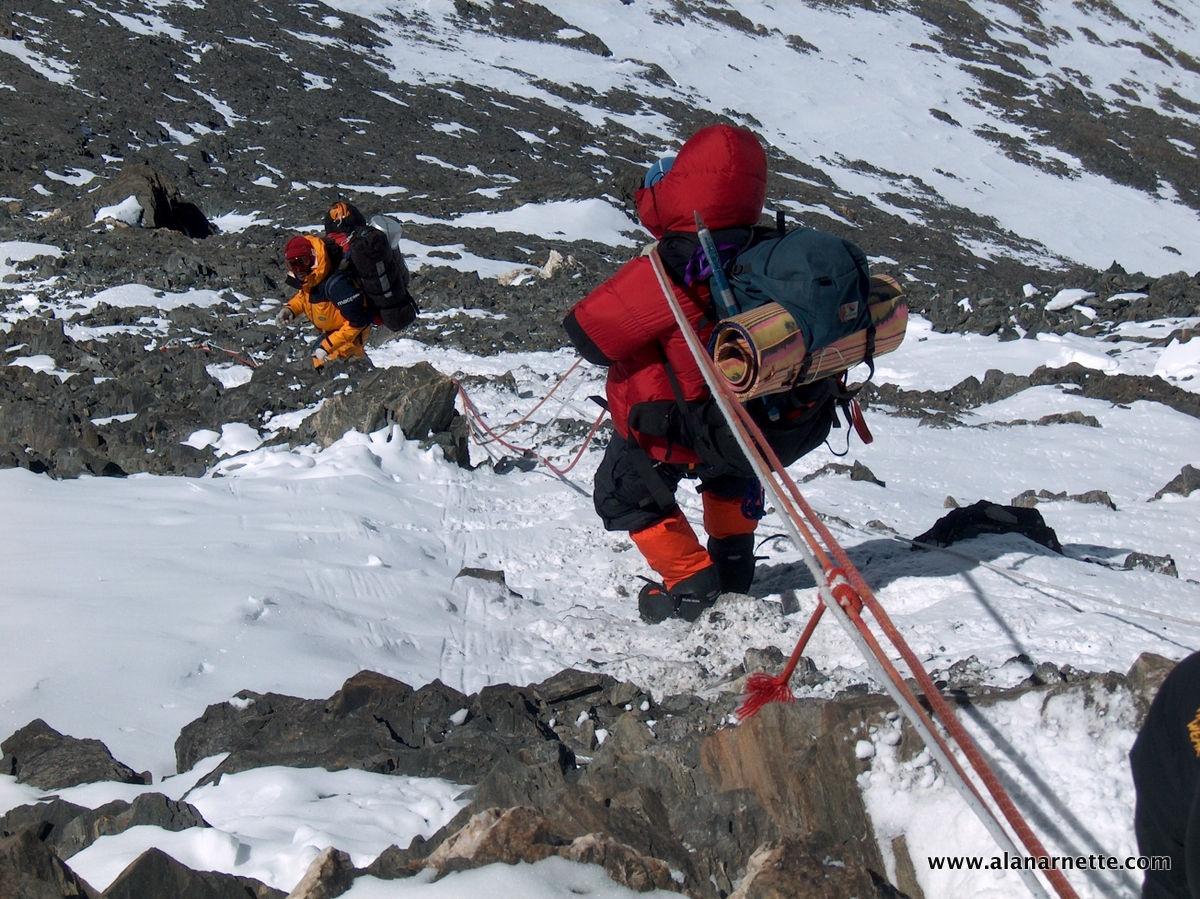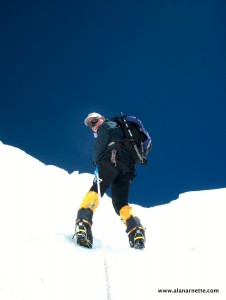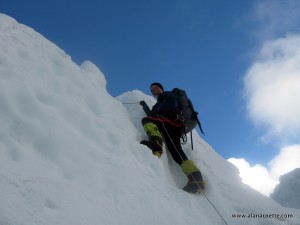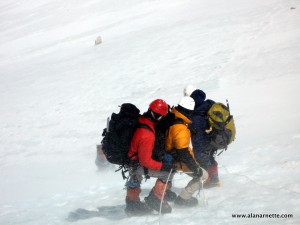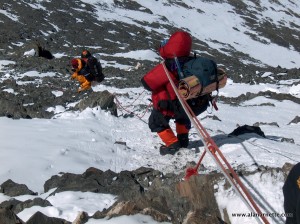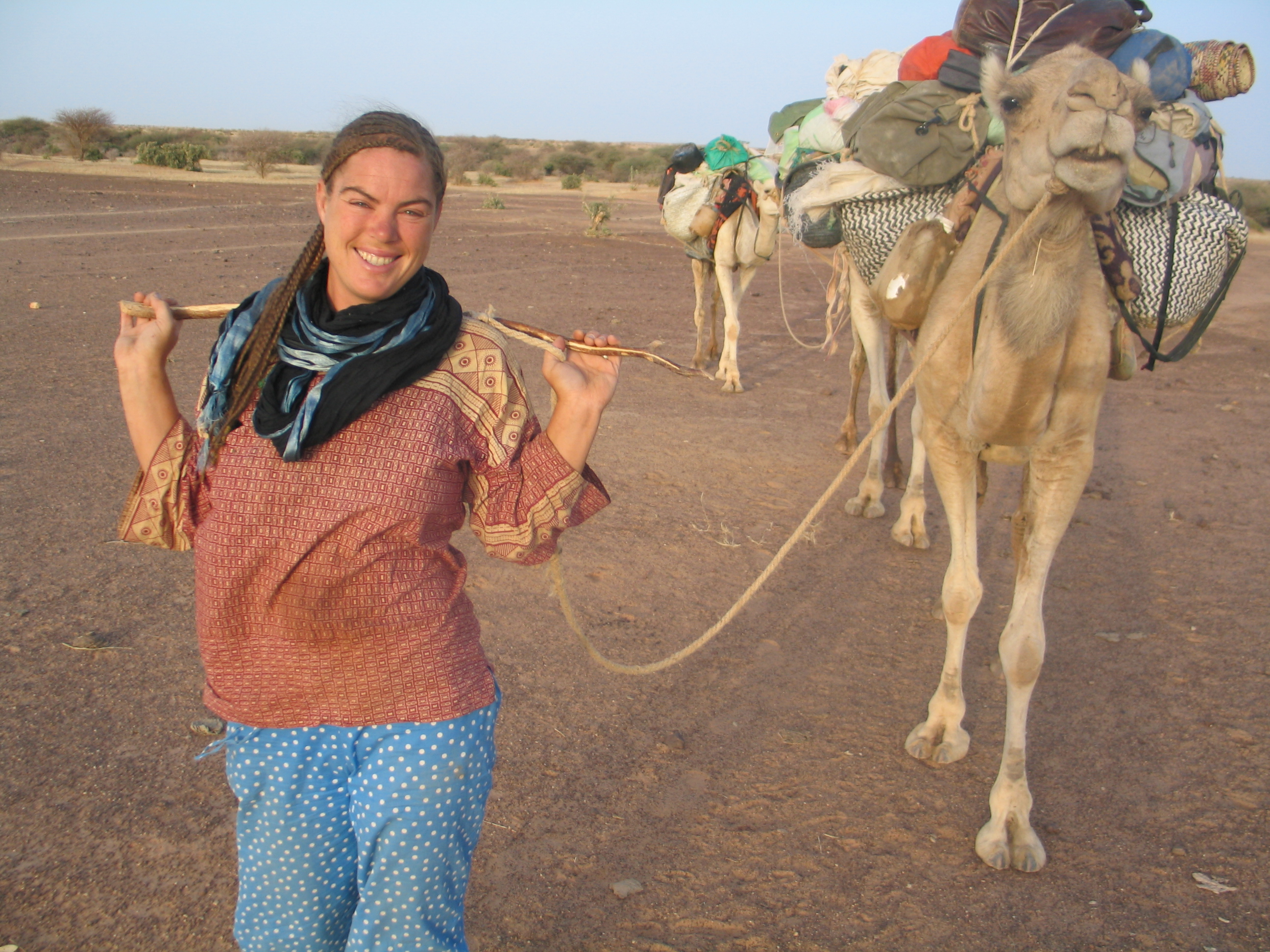Alan Arnette has definitely opened my eyes a lot as regards to the Everest issue. And I think the title of his article is splendid and hits the spot immediately. the highest mountain on earth deserves respect. And I don´t think it is only in climbing circles that Everest has picked up fault finding critique, but also from the other adventurous communities. Mostly due to ignorance of the real facts that Alan Arnette is presenting below here. And I am sure a major piece of jealousy for not having summited Everest themselves! I have added it on my bucket list again after reading Alan´s article. I will try to persuade my wife and daughters to join me the day they´re ready. My wife has always wanted to attempt a climb. And my daughters can help their old dad over the Hillary Step. This article complements Alan´s last article, Mount Everest; What Is Wrong With It?
Everest Deserves Respect
By
Alan Arnette
Over four days in May 2012, around 250 Westerners and 270 Sherpas and Tibetans support climbers summited Mt. Everest. For many, attaining highest point on Earth was the culmination of endless training, personal sacrifices and hard work to achieve a meaningful and fulfilling lifelong dream.
Yet it is common within the greater climbing community to bash Everest climbers, for using ladders in the Khumbu ice fall, for relying on bottled oxygen up higher, for having Sherpas carry their gear, fix their ropes and establish their camps. For the critics on the sidelines, Everest has become a joke. I am disturbed by what I feel is a trend to vilify Everest and its climbers, and by the vast amount of misleading information that fuels the fire of controversy.
Fact is, Everest is hard. Damn hard. Strong, experienced climbers have dropped dead from the effort or exposure. Pushing above 8,000 meters is like venturing into space. The slightest miscalculation or misstep will kill you. Few climbs in the world are as unforgiving. Everest is a worthy mental and physical challenge and it deserves respect. Anyone who says otherwise has either not climbed it, lacks the courage to reveal their own struggles during the climb, or lacks the objectivity to honestly take pride in their achievement.
LOVE IT OR HATE IT
Climbers find many faults with Everest, but to disparage climbing it because the ascent or scene doesn’t conform to a certain idea of what mountain climbing should be is simply not right.
The climbing community is often its own worst enemy, suffering from “friendly fire” that ranges from bolt wars on crags, to Everest. Our casual criticisms hurt everyone. It does not help that even some of the biggest names on Everest cast the mountain and its climbers in a negative light.
Simone Moro, one of the world’s leading alpinists and mountaineers, and who abandoned his Everest attempt without supplemental oxygen this year due to overcrowded conditions, described the scene as similar to an “amusement park,” and said that he was “astonished” to see climbers “who don’t know how to use a jumar ”
It is true that there are some ill-prepared participants who should not be on Everest, but you can find people who don’t know how to properly use their jumars on El Cap. The average Everest climber in recent years may not be as inexperienced as you have been led to believe. Many have been on Denali or Aconcagua or climbed on other 8000-meter peaks such as Cho Oyu. The best guides do not accept inexperienced climbers, but there are those who do, and these are the ones who make headlines.
This year, for instance, the Nepalese outfitter Thamserku accepted the 46 year0-old Turkish New Yorker Aydin Irmak. Despite Everest being his first-ever climb, and despite initially being refused a permit — he threatened to burn himself alive if he was denied –Irmak summited, although he faltered on the descent and had to be rescued below the summit.
Perhaps referring in part to Irmak, Ralf Duimovits, the 16th person to climb all 14 8,000-meter peaks, and who took the now ubiquitous photo of the long line on Everest this season, said “it takes no skill to do what most of the tourists to Everest do. The growing trend in the last 10 years has been to use oxygen almost from base camp onwards, whereas for decades it was only considered to be normal to use it from 8,000 meters onwards. Now they drink it like it was water.”
The fact is almost every climber starts using a low flow of supplemental oxygen as they leave Camp III at 7,172 meters for their summit push, and nowhere near basecamp.
Critical comments can be constructive, but ones that are inaccurate and sensationalized for the media do nothing to instill a sense of pride or accomplishment in our sport and make it harder for everyone to move forward. If Everest is ridiculous, why do we see famous names on the permit lists? Why do the most reliable operators fill their expeditions each year with qualified climbers?
The press, in particular, seems to relish painting a distorted view of Everest. After the May 18 and 19 weekend this year that saw four westerner deaths, CNN asked if Everest was “a morgue” and wrote that the deaths were due to a “deadly traffic jam.”
The media loves publishing photos of long lines of climbers and reports of delays at the Hillary Step. They decry the hordes of “rich” climbers and jump on quotes from notables such as Conrad Anker, who climbed Everest without supplemental oxygen this year and said that climbers break out into two groups, the “hardcore climber that saves up,” and “the trophy hunter, someone that … has done well in business and has the money, has $70,000 to get a ride up Mount Everest, and they want the trophy on the wall.”
Unfortunately, people tend to ignore the first category of climbers. Certainly, climbing Everest takes a lot of money, but as Anker noted, not all Everest climbers are wealthy and plenty have made life-changing sacrifices for the opportunity to climb. In my expeditions with over 40 climbers I have only seen a few I would describe as rich. Most have been hard-working people who made climbing Everest a priority. One of my teammates took out a second loan on her house to finance her climb; today she says she has no regrets.
You would be hard pressed to find another climb or discipline that brings out such passion and commitment.
BEHIND THE 2012 CROWDS
The iconic image from 2012 was of a long queue of climbers on the Lhotse Face. What was missed was that about half of those climbers were Sherpas, not Westerners, and most were not summit bound: They returned to lower camps after ferrying loads to the higher camps. Some commercial operators such as International Mountain Guides and Himalayan Experience have twice as many Sherpas as clients, a turn around from previous years, and they put more Sherpas on the summit than clients.
Why all the Sherpas? Climbing Everest takes an enormous amount of manpower. Even back in 1963 the legendary West Ridge climb used 900 porters and 37 Sherpas for five Western summiters, a staggering 7.4:1 ratio for that pioneering expedition.
According to 8000ers.com, since 1953, of the over 3,400 individuals who have reached the summit of Everest, almost 1,000 were by first category of climbers.
I do believe that adding more Sherpas to attract unprepared climbers is not a sound strategy, as the larger safety net will tempt more unprepared clients to tackle Everest. I would instead prefer to see operators raise the bar for their clients.
2012: A NORMAL YEAR
The number of climbers on Everest in 2012 was typical of the past 10 years. What made this season unique was the bad, dry weather, which yielded only four summit days in May, compared to the average of six. With a narrower window, the traffic seemed abnormally high.
Ten climbers died on the mountain including three Sherpas, and not one was the result of crowding.
Each death was unique and mostly a function of the well-known risks of high-altitude mountaineering. Four died from altitude illness/exhaustion; three died in falls; two had strokes and one from another illness.
But with the deaths and images of climbers standing in line, the press and some pundits reported mayhem. Even the venerable NPR ran a story with the headline “Maybe Everest Needs A Traffic Cop; At Least Four Climbers Dead.”
What was ignored was the deep satisfaction brought to hundreds of deserving climbers and employment to hundreds of Sherpas. Sadly there will be more tragedies such as those this year, but the only perfect solution is to stop all climbing.
I guess the ladders could be removed from the Khumbu, the fixed ropes taken off the Lhotse Face and supplemental oxygen banned. These changes would reduce the number of climbers, accidents and deaths. But they would also limit the opportunity to climb Everest from hundreds to a few. This purists’ strategy goes against my belief that the mountains are for everyone, and I think that most climbers don’t want their sport regulated.
At the end of the day, each climber takes every step powered by their own strength and willingness to push themselves beyond their perceived limits. It is simply not right to belittle Everest climbers due to ideological differences. A little respect for every climber is deserved, regardless of their style, age or result.
RESPECT IN ADVENTURE
I remember as a kid watching Neil Armstrong walk on the moon, reading of Hillary and Norgay on Everest, of Bonington’s expeditions, and having an insatiable appetite for anything adventurous. These pioneers planted a seed in me that grew into my own adventures even though I was never first up any mountain or never opened a new climb, but what I have accomplished were all firsts for me and of that I am proud.
It is not a reason to avoid an adventure because someone else has already been there. Each event is personal and unique and is open for our personal touch. It is worth noting that since the first American ascent of Everest in 1963, only 450 Americans have stood on top. Compare this to the 492 people who have climbed Denali this summer alone, and the 20,056 who have summited Denali in total.
Sir Chris Bonington summed it up well when he said:
“For every individual who gets to the top of Everest it is a life-changing experience, and I would hate to deny anyone that. When I summited Everest it was my last chance of getting up. It’s an extraordinary experience and I think it is terrific for an ordinary person who has that dream to achieve it.”
When Sir Edmund Hillary was 83 he said that he was sad to see the crowds on Everest, but when he was asked if he were 50 years younger if he would still want to climb Everest, he smiled and replied, “I suppose I would.”
Climb On!
Alan
Memories are Everything
This article was published in the October 2012 print edition of Rock and Ice magazine. It is a compliment to my recent posts on this site, What is Wrong with Everest.
